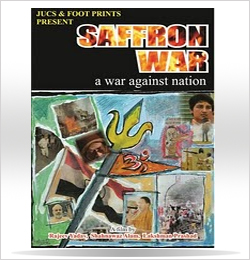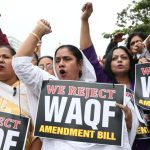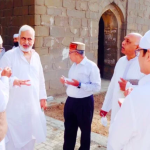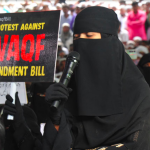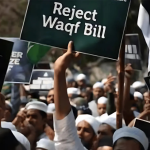Zeeshan Husain for BeyondHeadlines
‘Saffron War’ is a film which focuses on the growing communalism in Gorakhpur in particular and eastern Uttar Pradesh in general. Directed by new entrants to the world of film-making, Lakshman Prasad, Rajeev Yadav and Shahnawaz Alam, it takes a detailed view of the Gorakhpur town and nearby areas in Gorakhpur division. The three young men must be applauded for daring to make a film on Yogi Adityanath and his activities. Made in 2011, it is more relevant now than it might have been eight years ago. Yogi Adityanath is, at present, the Chief Minister of UP, and Bharatiya Janata Party (BJP) has started its second term in the Parliament. Slowly the discourse of the Sangh Parivar is getting normalised, and we are marching towards “Israel-type ethnic democracy” (Jaffrelot, 2018). Ethnic democracy means democracy which on paper propogates equality of all citizens but in practice considers only one religious group (Jews in the case of Israel) as truly citizens. The film has a deep desire to prevent that. It is fighting for multi-cultural India which has been envisaged by its founding fathers- Gandhi, Nehru and Ambedkar. The fight is getting tougher.
Yogi is a Hindi word which means a saint. Yogi Adityanath is the chief priest (mahant) of the Gorakhnath Mandir situated in Gorakhpur. Gorakhpur takes its name from the medieval saint Gorakhnath after whom the temple is also named. The film elaborates how the tension between other-worldly sainthood is managed (manipulated) by Adityanath who is definitely this-worldly. There are two contradictory strands within this brand of politics. First is where sainthood means leaving this-worldly activities and working for the spiritual well-being of oneself and others. There are interviews of priests from various temples which gives us their viewpoint on sainthood which is quite antithetical to the one held by Adityanath. The other strand is signified by Adityanath and his two predecessors, namely Digvijay Nath (a member of Hindu Mahasabha, and MP Gorakhpur in 1967) and Mahant Avaidyanath (MLA from Maniram and MP from Gorakhpur). This strand deals with the union of politics and religion. One wonders if India is heading towards a theocracy replacing the Constitution with the Manusmriti.
Saffron War shows us clearly that Yogi Adityanath’s style of politics has violence against Muslims as the core and the most disturbing agenda. This goes against the teachings of saint Gorakhnath (10th-11thcentury) and the history of Gorakhnath temple itself. Interviews of various journalists, scholars and historians tell us that Saint Gorakhnath’s teachings were full of humanity and compassion. India under the Sultanates was without an ill feeling of communalism. The temple had Muslim fakirs and singers till late 1950s.
Saffronisation of the temple began after the mahants started joining politics and opted for gradual riddance of Muslim mendicants from the temple. (Lyold Rudoph calls it ‘modern hate’). One expert tells us that the acres of land which the temple owns are actually a gift by Asaf-ud-Daula, nawab of Awadh. The syncretic tradition was slowly eroded in post-colonial India.
Violence against Muslims is now projected as an act of self-defence. Young minds are indoctrinated with booklets saying that Islam cherishes violence against Hindus. There is an organisation namely Arya Veer Dal where young boys are trained in using wooden sticks, swords and other simple weapons in the name of self-protection. There are shots of youth members of Hindu Yuva Vahini speaking about protection of Bharat Mata from Muslims. Most of them unemployed, from poor families, are flashing swords and shouting- Hindustan mein rehna hoga to Yogi Yogi kehna hoga (If you want to live in India, hail Yogi). This is what Paul R. Brass (2004) calls an ‘institutionalised riot system’ by which he means well-organised riots over months, sometimes even years.
It is here that the film could have touched upon why the image of Sainthood is used and how it shrouded the issue of development. What is the agenda for developing Gorakhpur division which consists of four districts namely Gorakhpur, Kushinagar, Deoria and Maharajganj? Will the Mahant and present CM of UP be ready to build schools, colleges, industries, roads, canals, hospitals, provide 24X7 electricity, provide loans to farmers, give various safety nets to peasants, distribute land to the landless, provide scholarships to students from poor backgrounds, make local bureaucracy hassle-free and make public transport more convenient.
Let us ask what the agenda of RSS is and its sister organisations for development. Let me tell my readers that eastern UP happens to be among our country’s most backward regions. Gorakhpur is one of the most backward districts as per government documents. There is still substantial control of Brahmins and Thakurs (Adityanath’s caste) over rural Poorvanchal (Hasan, 1988). The film could have focused more on this.
Related to the issue of development is the issue of socio-economic inequality based on caste and gender. The film has passing mentions but not a sound description of the slowing down of caste-based movements and parties. In present times, we have data to show that structural (material/economic) oppression of OBCs and physical violence against SCs are still high. Indeed economic inequality between castes is increasing (Srivastava, 2017), and atrocities against Dalits are also on a rise (The Indian Express 14th April 2018).
The film could have asked why lower caste parties failed to engage with the youth, and why even Dalits are leaving Ambedkarite project and joining saffron war (See Badri Narayan’s Fascinating Hindutva2009). As per CSDS 2019 post-poll survey, almost half of the non-Jatav Dalits have voted for BJP. More than two-thirds of OBCs have voted for BJP.
Last and most important is the issue of women. A member of HYV calls for raping the corpses of Muslim women. There is a small yet heart rendering interview in the movie of a Muslim mother-daughter duo who were victims of gang-rape. Adityanath himself has been objectifying women in many clips. He calls for taking (read abducting) 10 Muslim girls for every 1 Hindu girl taken (read married to a Muslim man). If one delves a little deep one will see, in actual practice women are pushed to marry against their choice by their own fathers and (elder) brothers even within the religion. Religious conservatism depends very much of the subjugation of its own women. Talk to your own woman friends and they would tell you the stories of rampant domestic violence, sexual abuse, discrimination in attaining education, etc. The film could have thrown light on how women are trained to be docile in the garb of maintaining honour of family, caste and religion, that forms one of the key tenets of the right-wing politics in India (Iyenger, 2017).
The movie deserves a serious consideration by both experts on communalism and laymen like me. Saffron war succeeds in convincing us that the sainthood of Adityanath is not only a war against Muslims but also a war against the poor and unemployed youth, a war against backward castes and Dalits and a war against women. Aptly sub-titled, it is actually a war against the nation.
(Zeeshan Husain is a student of Uttar Pradesh society and politics.)
Works Cited
Brass, P. R. (2004, October 30). Development of an Institutionalised Riot System in Meerut City, 1961 to 1982. Economic and Political Weekly, pp. 4839-4848.
Habib, I. (2007). Medieval India: The Study of a Civilisation. New Delhi: National Book Trust.
Hasan, Z. (1988). Power and Mobilisation: Patterns of Resilience and Change in Uttar Pradesh Politics. In F. F. Frankel, & M. Rao, Dominance and State Power in Modern India: Decline of a Social Order Vol. 1 (pp. 133-203). New Delhi: Oxford Univerty Press.
Iyenger, R. (2017, June 14). RSS women’s wing focuses on gender-specific roles to uphold family values. Retrieved from The Indian Express: https://indianexpress.com/article/india/rss-womens-wing-tells-its-women-a-mans-job-is-to-make-money-womans-quality-is-motherhood/
Jaffrelot, C. (2018, December 4). Hindu nationalism and the ‘saffronisation of the public sphere’: an interview with Christophe Jaffrelot. 468-482. (E. Anderson, Interviewer) Contemporaray South Asia.
Narayan, B. (2009). Fascinating Hindutva: Saffron Politics and Dalit Mobilisation. Sage.
Rudolph, L. I., & Rudolph, S. H. (1993, March 22). Modern Hate. The New Republic, pp. 24-29.
Srivastava, R. (2017, November 9-12). 43rd All India Sociological Conference. Lucknow, Uttar Pradesh, India: Indian Sociological Society.

